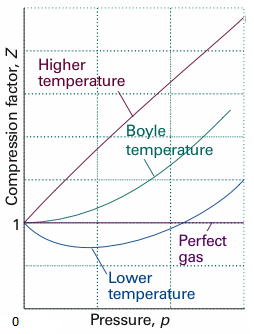
What is Boyle temperature?
Answer
581.7k+ views
Hint: Boyle temperature is described for real gases. Real gases do not adhere to the law of ideal gas and the particles of real gases have volumes.
Complete step-by-step solution:
Boyle temperature can be defined as the point in the temperature range in which a real gas starts to behave like an ideal gas at a pressure range. The temperature at which the second coefficient in the expression becomes zero is known as a Boyle temperature. This Boyle temperature balances out the attractive and the repulsive forces that are acting on a gas particle.
We can use the virial equation of state to calculate the Boyle temperature. Boyle temperature can be expressed in the terms of the virial coefficients.
$Z = 1 + \dfrac{B}{{{V_m}}} + ....$
Additional information:

The above graph is plotted between the pressure $p$and compressibility factor$Z$. Boyle temperature is nicely marked in the graph. From this point, the real gas starts to behave like an ideal gas. The compression factor $Z$ is given as,
$Z = \dfrac{{p{V_m}}}{{RT}}$
Here, $Z$is the compressibility factor, ${V_m}$ is the volume,$R$ is the gas constant, $T$ is the
temperature and $p$ is the pressure.
$Z = 1$ for an ideal gas. Real gases show some deviation.
Note: Critical Temperature is different from Boyle's temperature. At the critical temperature, a gas shows non-ideal behavior. Critical temperature is lower than the Boyle temperature. At Boyle temperature a gas starts to behave like an ideal gas and for ideal gas, the compressibility factor is 1, that is, $Z = 1$
Complete step-by-step solution:
Boyle temperature can be defined as the point in the temperature range in which a real gas starts to behave like an ideal gas at a pressure range. The temperature at which the second coefficient in the expression becomes zero is known as a Boyle temperature. This Boyle temperature balances out the attractive and the repulsive forces that are acting on a gas particle.
We can use the virial equation of state to calculate the Boyle temperature. Boyle temperature can be expressed in the terms of the virial coefficients.
$Z = 1 + \dfrac{B}{{{V_m}}} + ....$
Additional information:

The above graph is plotted between the pressure $p$and compressibility factor$Z$. Boyle temperature is nicely marked in the graph. From this point, the real gas starts to behave like an ideal gas. The compression factor $Z$ is given as,
$Z = \dfrac{{p{V_m}}}{{RT}}$
Here, $Z$is the compressibility factor, ${V_m}$ is the volume,$R$ is the gas constant, $T$ is the
temperature and $p$ is the pressure.
$Z = 1$ for an ideal gas. Real gases show some deviation.
Note: Critical Temperature is different from Boyle's temperature. At the critical temperature, a gas shows non-ideal behavior. Critical temperature is lower than the Boyle temperature. At Boyle temperature a gas starts to behave like an ideal gas and for ideal gas, the compressibility factor is 1, that is, $Z = 1$
Recently Updated Pages
Why are manures considered better than fertilizers class 11 biology CBSE

Find the coordinates of the midpoint of the line segment class 11 maths CBSE

Distinguish between static friction limiting friction class 11 physics CBSE

The Chairman of the constituent Assembly was A Jawaharlal class 11 social science CBSE

The first National Commission on Labour NCL submitted class 11 social science CBSE

Number of all subshell of n + l 7 is A 4 B 5 C 6 D class 11 chemistry CBSE

Trending doubts
10 examples of friction in our daily life

One Metric ton is equal to kg A 10000 B 1000 C 100 class 11 physics CBSE

Difference Between Prokaryotic Cells and Eukaryotic Cells

1 Quintal is equal to a 110 kg b 10 kg c 100kg d 1000 class 11 physics CBSE

State the laws of reflection of light

Explain zero factorial class 11 maths CBSE




